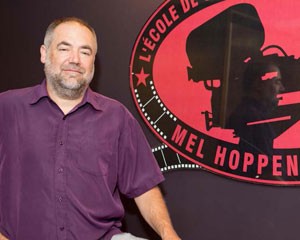Describe your career path.
I make theatrical documentary cinema, documentaries that use the language and aesthetics of cinema; social issue pointof- view (POV) documentaries that break down mediated stereotypes; films about people not justly represented in corporate media; cinema verité rather than experts or talking heads.
At the age of 26, I applied to Concordia and King’s College [in Halifax]. The King’s College advisor reviewed my transcript and said, “Your transcript does not confirm you can read or write… I suggest you apply to phys ed.” I walked out before he finished his next sentence. Concordia accepted me as a mature student in cinema-film production. With boyhood dreams of playing for the Canadiens and filmmaking desires fuelled by the NFB [National Film Board of Canada] in Montreal, I immediately accepted.
Do you think about your legacy, the mark you leave on others?
When you’re successful in getting a film budget, it could be $200,000, which is relatively well financed considering I’m working with homeless people [such as in The Street: A Film With the Homeless (1997) and S.P.I.T.: Squeegee Punks in Traffic (2002)].
Therefore, I ensure that my filmmaking process has a positive impact on the subjects’ dayto- day realities. As a filmmaker, I get involved in the realities both in front of and behind the camera. I do not see this as an ethical dilemma. When I get involved, I make a better film. I created HomelessNation.org [a website by and for the street community] as an activist project. I believe self-expression builds self-esteem.
Who influenced you?
My dad was a real community activist, a member of the Ridgeway Crystal Beach Kinsman club. I became his front man in community fundraising campaigns after he realized that a kid showing up at the door gets a better response than an adult. So from him I developed my social conscience and activist attitude. Then there was Katimavik, a federal government youth program, where I travelled across Canada with 30 others, performing community work. We were sent to Lund, B.C., situated at the end of the Trans-Canada Highway along the Sunshine Coast two or three ferry rides from Vancouver. I started a teen-youth group there and began showing NFB films like Never Cry Wolf [1983]. It was my first inkling into the idea of becoming a filmmaker.
What role did Concordia and your professors have on your progress?
My mentor was cinema professor Thomas Waugh. He was my academic advisor when I came to Concordia. Because of him, I was able to enrol in the History of Film course, which exposed me to the world of cinema, showing me the kind of films I wanted to make.
There was also NFB camera operator, cinematographer and director Martin Duckworth, also a part-time Concordia professor. He helped me get extra film stock to complete my first films. By the end of my second year at Concordia, I had my films in festivals.
Do you consider yourself a mentor?
I received the inaugural Mentor Award from the Canadian Film and Television Producers Association in 2006. There’s a really good relationship between my mentoring students and giving them opportunities through EyeSteelFilm. Yung Chang [BFA 99], who made Up the Yangtze [2007], and Brett Gaylor [BFA 99], who made RiP: A Remix Manifesto [2009], were students of mine. Then there’s Eric Denis, also known as Roach, from SPIT. He got off the street and IV drugs as a result of filmmaking and is now completing his fifth movie with EyeSteelFilm.
Your profession faces increasing challenges. How do you foresee it evolving?
TV is our major financial outlet. The rise of fact-based entertainment and reality TV means there’s less space on TV for POV documentaries. On the other hand, equipment is cheaper than ever, so films cost less to make and, with the web, they’re more and more accessible. The problem is that web distribution hasn’t really been monetized yet.
One of the good things about teaching at university is working with young people. Students are arriving with a new literacy in media; that seems to be innate in all young people. Now the challenge is for me — us — to keep up.
— Beverly Akerman


 Joyce Napier is now Radio-Canada’s Washington, D.C., correspondent.
Joyce Napier is now Radio-Canada’s Washington, D.C., correspondent.
 Bishop Tom Dowd became Canada’s youngest bishop in 2011.
Bishop Tom Dowd became Canada’s youngest bishop in 2011.
 Concordia professor and filmmaker Daniel Cross received the inaugural mentor award from the Canadian Film and Television Producers Association in 2006.
Concordia professor and filmmaker Daniel Cross received the inaugural mentor award from the Canadian Film and Television Producers Association in 2006.
 Gina Cody is president of CCI Group in Toronto.
Gina Cody is president of CCI Group in Toronto.
 Guru Energy Drink co-founder and VP Marketing Ray Jolicoeur.
Guru Energy Drink co-founder and VP Marketing Ray Jolicoeur.